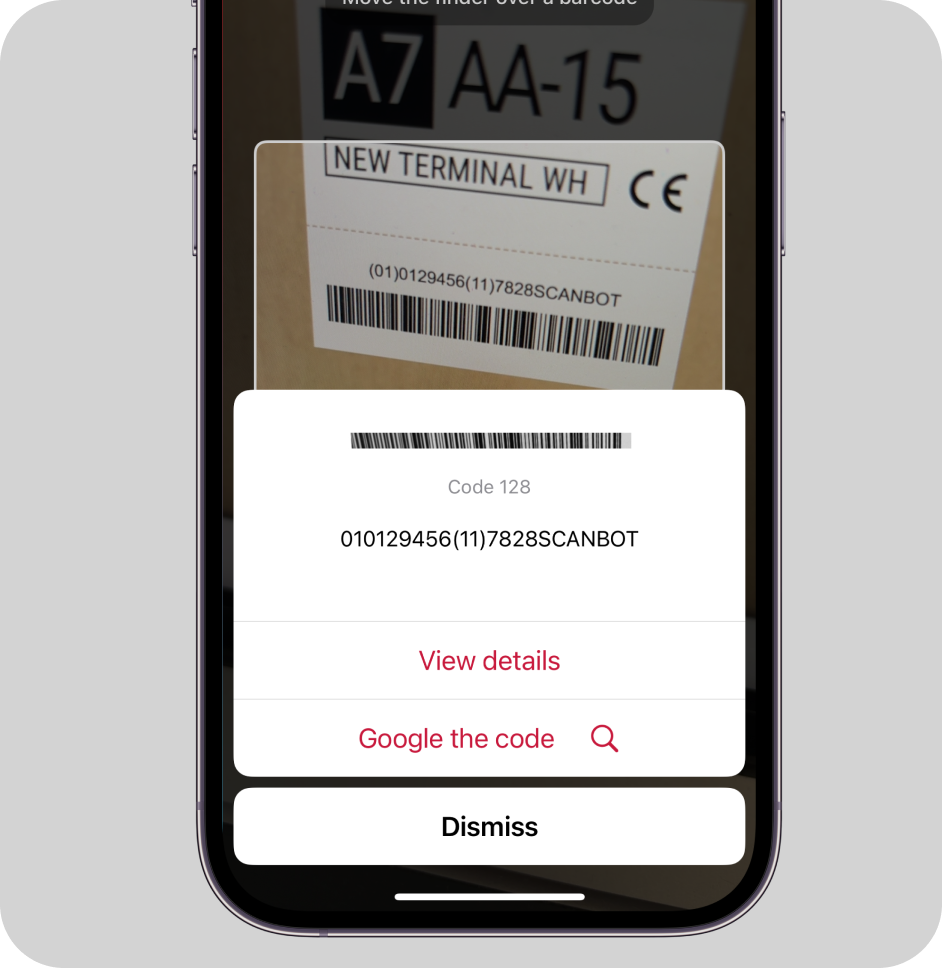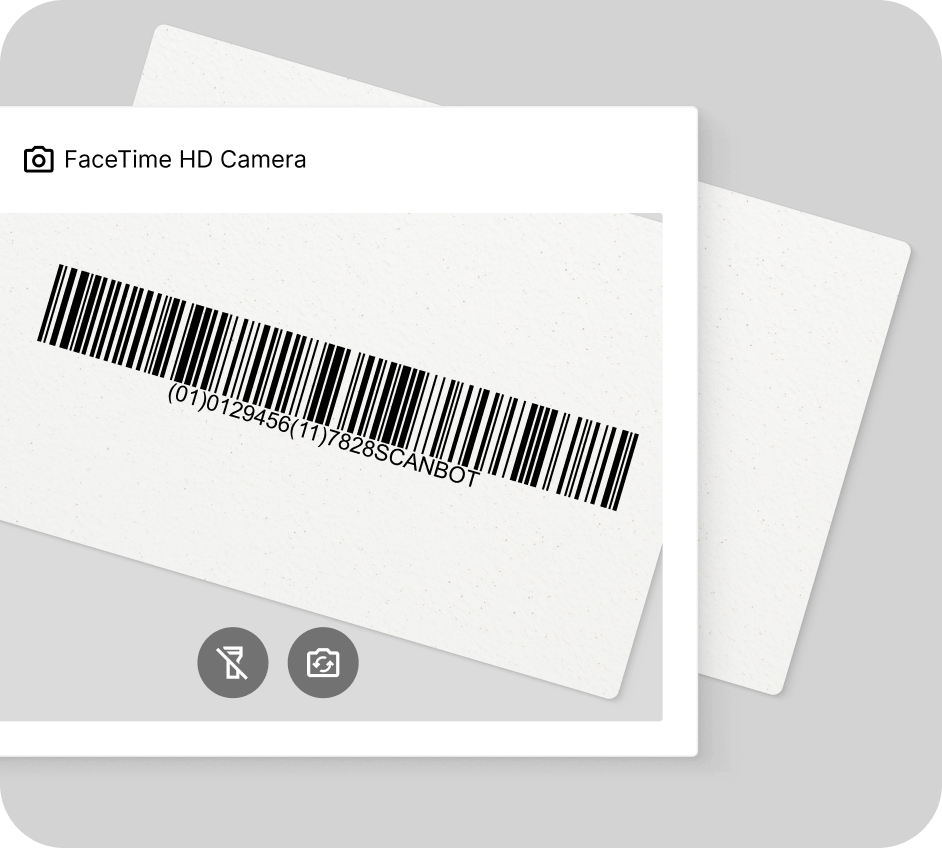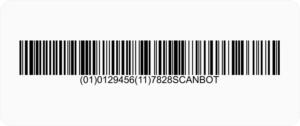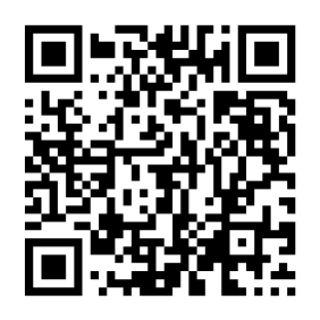GS1-128 Barcode Scanner
Add GS1-128 barcode scanning to your mobile application or website
Trusted by
400+
global
industry leaders
Turn smartphones into fast & reliable GS1-128 barcode scanners
The Scanbot GS1-128 Barcode Scanner SDK delivers exceptional performance even under challenging conditions – such as code damage or when scanning the very small codes commonly found in industrial environments. With a scanning speed of under 0.04 seconds, your users get instant reads for seamless workflows.
Key benefits include:
- Offline scanning: The Scanbot SDK works 100% on-device, ensuring both uninterrupted performance and data security.
- Enterprise support: Questions or requests? Contact our technical support team. We’re happy to assist you.
- Flat pricing model: Cost stays the same no matter how much your user base or scanning volume grows.


How this scanning tool works
Our free online GS1-128 barcode reader scans codes directly through your camera or on imported images. This barcode scanner works in any browser, no app download or signup needed. Enjoy real-time camera view scanning or decode barcodes on pictures in seconds – just point your camera at the code or import an image file to instantly access the encoded data.
This tool is powered by the Scanbot Barcode Scanner SDK!
(We don’t store any images or data you import. Everything stays on your device.)
Understanding GS1-128 barcodes
What are GS1-128 barcodes?
The GS1-128 code is a versatile one-dimensional (1D) barcode widely used for product identification and supply chain management across various industries including retail, logistics, healthcare, and manufacturing. It is based on the Code 128 symbology and was previously known as EAN-128 or UCC-128.

GS-128 codes incorporate a Function Code 1 (FNC1) character and Application Identifiers (AIs) to structure data. The FNC1 character identifies the barcode as GS1-128, signaling to scanners that the data follows GS1 standards. AIs are numerical prefixes that define the meaning and format of the data that follows, enabling standardized encoding of diverse information such as GTINs, batch numbers, expiry dates, and weights.
They can carry up to 48 characters of alphanumeric data, with a maximum physical length of 165.10 millimeters. Unlike UPC or EAN codes used primarily at point-of-sale, GS1-128 allows for combining multiple data elements in a single barcode, enhancing traceability and regulatory compliance. This feature also facilitates automation in logistics and improves inventory management efficiency.
Applications of GS1-128 barcodes
Logistics and shipping
GS1-128 barcodes are highly valuable in shipping, receiving, and warehouse scanning environments because they can encode detailed product information, including batch or lot numbers, serial numbers, and expiration dates.
Healthcare
In healthcare, they ensure patient safety by encoding unique device identification (UDI) and pharmaceutical traceability. They help track medical products from manufacturing to patient use, supporting critical regulatory compliance.
Retail and food service
Most major retailers and food service operators use GS1-128 barcodes to enhance inventory management, automate receiving processes, and improve product traceability. These barcodes are especially valuable for tracking expiration and production dates and batch numbers in food safety initiatives.
Advantages of GS1-128 barcodes
- Data capacity: GS1-128 can encode up to 48 characters of alphanumeric data, allowing for detailed product information in a single barcode.
- Standardization: As part of the GS1 system, these barcodes ensure global compatibility and standardized data interpretation.
- Length: GS1-128 barcodes can be up to 165.10 millimeters (6.500 inches) long, including quiet zones, allowing for significant data encoding in a linear format.
- Versatility: GS1-128 barcodes can encode various types of information using Application Identifiers (AIs), making them adaptable for different supply chain needs.
Structure of GS1-128 barcodes
Multiple pieces of information can be combined in a single GS1 barcode, with the FNC1 character serving as a separator between different data items. The barcode begins with a unique double character start pattern consisting of a start character followed by the FNC1 character, distinguishing it from regular Code 128 symbols. The key components are:
- Start Character: Indicates the beginning of the barcode (START-A, START-B, or START-C). It is an internal part of the barcode’s encoding that helps the scanner determine how to interpret the data.
- FNC1 Character: Flagging character that identifies the barcode as a GS1-128 and acts as a separator for variable-length data.
- Application Identifiers (AIs): Two to four-digit numerical prefixes that define the meaning and format of the following data. For example:
- (01) represents a Global Trade Item Number (GTIN)
- (10) indicates a Batch or Lot Number
- (17) signifies an Expiration Date
- Data Elements: The actual information being encoded, such as product numbers, dates, or quantities. The format and length depend on the preceding Application Identifier (AI). This data is encoded as a text string within the barcode, enabling precise data interpretation.
- Symbol Check Character: A single character calculated from all preceding data, used for error detection.
- Stop Character: Indicates the end of the barcode. It is an internal part of the barcode’s encoding and remains invisible to users.
The human-readable text below the barcode displays this information, with Application Identifiers (AIs) in parentheses to indicate what each piece of data represents.
Why choose the Scanbot SDK for GS1-128 barcode scanning?
The Scanbot Barcode Scanner SDK is specifically designed to handle the challenges of decoding GS1 barcodes in real-world scenarios.
What sets us apart:
- Exceptional performance: Reliably decodes even damaged, low-contrast or distorted barcodes.
- High-speed scanning: Read GS1-128 codes in as little as 0.04 seconds.
- Cross-platform compatibility: Easily integrate with Android, iOS, cross-platform, web, Windows, and Linux platforms.
- Customizable UI: Customize the ready-to-use components to match your app or website design.
- Privacy-first: Operates offline for complete data security.
Whether your use case involves GS1 barcodes, QR codes or any other barcode, the Scanbot SDK delivers the accuracy, speed, and reliability you need to succeed.
Related Barcode Types:
- Data Matrix Scanner
- QR Code Scanner
- PDF417 Scanner
- Aztec Code Scanner
- Code 128 Scanner
- Code 39 Scanner
- EAN Scanner
- UPC Scanner
- Micro QR Code Scanner
- GS1 DataBar Scanner
- GS1 DataMatrix Scanner
- MaxiCode Scanner
- ITF Scanner
- Codabar Scanner
- Intelligent Mail Barcode Scanner
- rMQR Code Scanner
- Royal Mail Scanner
- Micro PDF417 Scanner
Frequently Asked Questions
What is a GS1-128 barcode?
A GS1-128 barcode is a versatile one-dimensional (1D) barcode used for product identification and supply chain management. It is based on Code 128 symbology and includes a Function Code 1 (FNC1) character and Application Identifiers (AIs) to structure data, enabling standardized encoding of various information.
Where are GS1-128 barcodes used?
GS1-128 barcodes are used in logistics for shipping and warehouse scanning, in healthcare for tracking medical products, and in retail and food service for inventory management and traceability. They encode detailed information like batch numbers and expiry dates.
What is the difference between Code 128 and GS1-128 barcodes?
Code 128 is a general barcode symbology that encodes alphanumeric data without context, while GS1-128 is a specific version of Code 128 that follows GS1 standards and uses Application Identifiers (AIs) to define the meaning of the data. GS1-128 is designed for supply chain management, allowing multiple data elements to be combined in one barcode.
How can Scanbot SDK help you with GS1-128 barcode scanning?
The Scanbot GS1-128 barcode scanner delivers exceptional performance in challenging environments, including damaged or curved barcodes, with a scanning speed of under 0.04 seconds for seamless workflows. Try it now with a free trial license.



